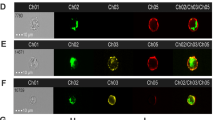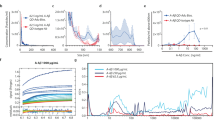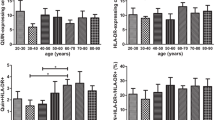Abstract
Sporadic Alzheimer’s disease (AD) is characterised by the deposition and accumulation of specific protein aggregates. Failure of clearance could underlie this process, and recent genetic association studies point towards involvement of the phagocytosis and autophagy pathways. We developed a real-time tri-color flow cytometry method to quantitate the phagocytic function of human peripheral blood monocyte subsets including non-classic CD14dimCD16+, intermediate CD14+CD16+ and classic CD14+CD16− monocytes. Using this method, we have measured the phagocytic ability of fresh monocytes in a study of preclinical, prodromal and clinical AD, matched with cognitively normal healthy control subjects. Basal levels of phagocytosis in all three subsets of monocytes were similar between healthy controls and AD patients, while a significant increase of basal phagocytosis was found in subjects with high Aβ-amyloid burden as assessed by PET scans. Pre-treating cells with Copaxone (CPX, to stimulate phagocytosis) or ATP (an inhibitor of P2X7-mediated phagocytosis) showed a differential response depending on clinical or Aβ-burden status, indicating a relative functional deficit. Overall the results are consistent with a perturbation of basal and stimulated innate phagocytosis in sporadic AD.






Similar content being viewed by others
Abbreviations
- CPX:
-
Copaxone (also known as glatiramer acetate)
- AD:
-
Alzheimer’s disease
- HC:
-
Healthy controls
- MCI:
-
Mild cognitive impairment
- SUVR:
-
Standardized uptake value ratio
- NMMHC-IIA:
-
Nonmuscle myosin heavy chain IIA
- FITC:
-
Fluorescein isothiocyanate
- APC:
-
Allophycocyanin
- mAb:
-
Monoclonal antibodies
- YG:
-
Yellow–green
- YO:
-
Yellow–orange
- CytD:
-
Cytochalasin D
- PBS:
-
Phosphate buffered saline
- PBMCs:
-
Peripheral blood mononuclear cells
References
Boche D, Zotova E, Weller RO et al (2008) Consequence of Aβ immunization on the vasculature of human Alzheimer’s disease brain. Brain 131:3299–3310. doi:10.1093/brain/awn261
Caragnano M, Tortorella P, Bergami A et al (2012) Monocytes P2X7 purinergic receptor is modulated by glatiramer acetate in multiple sclerosis. J Neuroimmunol 245:93–97. doi:10.1016/j.jneuroim.2012.02.002
Chan G, White CC, Winn PA et al (2015) CD33 modulates TREM2: convergence of Alzheimer loci. Nat Neurosci 18:1556–1558. doi:10.1038/nn.4126
Chen X, Hu J, Jiang L et al (2014) Brilliant Blue G improves cognition in an animal model of Alzheimer’s disease and inhibits amyloid-β-induced loss of filopodia and dendrite spines in hippocampal neurons. Neuroscience 279:94–101. doi:10.1016/j.neuroscience.2014.08.036
Clark CM, Pontecorvo MJ, Beach TG et al (2012) Cerebral PET with florbetapir compared with neuropathology at autopsy for detection of neuritic amyloid-β plaques: a prospective cohort study. Lancet Neurol 11:669–678
Clark CM, Schneider JA, Bedell BJ et al (2011) Use of florbetapir-PET for imaging β-amyloid pathology. JAMA 305:275–283. doi:10.1001/jama.2010.2008
Crehan H, Hardy J, Pocock J (2013) Blockage of CR1 prevents activation of rodent microglia. Neurobiol Dis 54:139–149. doi:10.1016/j.nbd.2013.02.003
Cros J, Cagnard N, Woollard K et al (2010) Human CD14dim monocytes patrol and sense nucleic acids and viruses via TLR7 and TLR8 receptors. Immunity 33:375–386. doi:10.1016/j.immuni.2010.08.012
Durafourt BA, Moore CS, Zammit DA et al (2012) Comparison of polarization properties of human adult microglia and blood-derived macrophages. Glia 60:717–727. doi:10.1002/glia.22298
Ellis KA, Bush AI, Darby D et al (2009) The Australian Imaging, Biomarkers and Lifestyle (AIBL) study of aging: methodology and baseline characteristics of 1112 individuals recruited for a longitudinal study of Alzheimer’s disease. Int Psychogeriatr 21:672–687. doi:10.1017/S1041610209009405
Fassbender K, Walter S, Kuhl S et al (2004) The LPS receptor (CD14) links innate immunity with Alzheimer’s disease. FASEB J 18:203–205. doi:10.1096/fj.03-0364fje
Fiala M, Halder RC, Sagong B et al (2015) omega-3 Supplementation increases amyloid-β phagocytosis and resolvin D1 in patients with minor cognitive impairment. FASEB J 29:2681–2689. doi:10.1096/fj.14-264218
Fiala M, Lin J, Ringman J et al (2005) Ineffective phagocytosis of amyloid-β by macrophages of Alzheimer’s disease patients. J Alzh Dis 7:221–232
Frenkel D, Maron R, Burt DS, Weiner HL (2005) Nasal vaccination with a proteosome-based adjuvant and glatiramer acetate clears β-amyloid in a mouse model of Alzheimer disease. J Clin Invest 115:2423–2433. doi:10.1172/JCI23241
Gu BJ, Baird PN, Vessey KA et al (2013) A rare functional haplotype of the P2RX4 and P2RX7 genes leads to loss of innate phagocytosis and confers increased risk of age-related macular degeneration. FASEB J 27:1479–1487. doi:10.1096/fj.12-215368
Gu BJ, Duce JA, Valova VA et al (2012) P2X7 Receptor-mediated scavenger activity of mononuclear phagocytes toward non-opsonized particles and apoptotic cells is inhibited by serum glycoproteins but remains active in cerebrospinal fluid. J Biol Chem 287:17318–17330. doi:10.1074/jbc.M112.340885
Gu BJ, Rathsam C, Stokes L, McGeachie AB, Wiley JS (2009) Extracellular ATP dissociates nonmuscle myosin from P2X7 complex: this dissociation regulates P2X7 pore formation. Am J Physiol Cell Physiol 297:C430–C439. doi:10.1152/ajpcell.00079.2009
Gu BJ, Saunders BM, Jursik C, Wiley JS (2010) The P2X7-nonmuscle myosin membrane complex regulates phagocytosis of non-opsonized particles and bacteria by a pathway attenuated by extracellular ATP. Blood 115:1621–1631. doi:10.1182/blood-2009-07-232587
Gu BJ, Saunders BM, Petrou S, Wiley JS (2011) P2X7 is a scavenger receptor for apoptotic cells in the absence of its ligand, extracellular ATP. J Immunol 187:2365–2375. doi:10.4049/jimmunol.1101178
Gu BJ, Sun C, Fuller S, Skarratt KK, Petrou S, Wiley JS (2014) A quantitative method for measuring innate phagocytosis by human monocytes using real-time flow cytometry. Cytometry A 85:313–321. doi:10.1002/cyto.a.22400
Guerreiro R, Wojtas A, Bras J et al (2013) TREM2 variants in Alzheimer’s disease. N Engl J Med 368:117–127. doi:10.1056/NEJMoa1211851
Hamilton JA, Whitty G, White AR et al (2002) Alzheimer’s disease amyloid β and prion protein amyloidogenic peptides promote macrophage survival, DNA synthesis and enhanced proliferative response to CSF-1 (M-CSF). Brain Res 940:49–54
Heneka MT, Carson MJ, El Khoury J et al (2015) Neuroinflammation in Alzheimer’s disease. Lancet 14:388–405. doi:10.1016/S1474-4422(15)70016-5
Hong S, Beja-Glasser VF, Nfonoyim BM et al (2016) Complement and microglia mediate early synapse loss in Alzheimer mouse models. Science 352:712–716. doi:10.1126/science.aad8373
Humphreys BD, Dubyak GR (1998) Modulation of P2X7 nucleotide receptor expression by pro- and anti-inflammatory stimuli in THP-1 monocytes. J Leukoc Biol 64:265–273
Ida N, Hartmann T, Pantel J et al (1996) Analysis of heterogeneous A4 peptides in human cerebrospinal fluid and blood by a newly developed sensitive Western blot assay. J Biol Chem 271:22908–22914
Kim WS, Hongyun L, Ruberu K et al (2013) Deletion of ABCA7 increases cerebral amyloid-β accumulation in the J20 mouse model of Alzheimer’s disease. J Neurosci 33:4387–4394. doi:10.1523/JNEUROSCI.4165-12.2013
Koronyo Y, Salumbides BC, Sheyn J et al (2015) Therapeutic effects of glatiramer acetate and grafted CD115(+) monocytes in a mouse model of Alzheimer’s disease. Brain 138:2399–2422. doi:10.1093/brain/awv150
Landa G, Butovsky O, Shoshani J, Schwartz M, Pollack A (2008) Weekly vaccination with Copaxone (glatiramer acetate) as a potential therapy for dry age-related macular degeneration. Curr Eye Res 33:1011–1013. doi:10.1080/02713680802484637
Lovelace MD, Gu BJ, Eamegdool SS et al (2015) P2X7 receptors mediate innate phagocytosis by human neural precursor cells and neuroblasts. Stem Cells 33:526–541. doi:10.1002/stem.1864
Masters CL, Bateman R, Blennow K, Rowe CC, Sperling RA, Cummings JL (2015) Alzheimer’s disease. Nat Rev Dis Prim 1:15056. doi:10.1038/nrdp.2015.56
McKhann G, Drachman D, Folstein M, Katzman R, Price D, Stadlan EM (1984) Clinical diagnosis of Alzheimer’s disease: report of the NINCDS-ADRDA Work Group under the auspices of Department of Health and Human Services Task Force on Alzheimer’s Disease. Neurology 34:939–944
Michaud JP, Bellavance MA, Prefontaine P, Rivest S (2013) Real-time in vivo imaging reveals the ability of monocytes to clear vascular amyloid-β. Cell Rep 5:646–653. doi:10.1016/j.celrep.2013.10.010
Ni J, Wang P, Zhang J, Chen W, Gu L (2013) Silencing of the P2X7 receptor enhances amyloid-β phagocytosis by microglia. Biochem Biophys Res Commun 434:363–369. doi:10.1016/j.bbrc.2013.03.079
Ostrowitzki S, Deptula D, Thurfjell L et al (2012) Mechanism of amyloid removal in patients with Alzheimer disease treated with gantenerumab. Arch Neurol 69:198–207. doi:10.1001/archneurol.2011.1538
Parvathenani LK, Tertyshnikova S, Greco CR, Roberts SB, Robertson B, Posmantur R (2003) P2X7 mediates superoxide production in primary microglia and is up-regulated in a transgenic mouse model of Alzheimer’s disease. J Biol Chem 278:13309–13317. doi:10.1074/jbc.M209478200
Petersen RC, Smith GE, Waring SC, Ivnik RJ, Tangalos EG, Kokmen E (1999) Mild cognitive impairment: clinical characterization and outcome. Arch Neurol 56:303–308
Prinz M, Priller J (2014) Microglia and brain macrophages in the molecular age: from origin to neuropsychiatric disease. Nat Rev Neurosci 15:300–312. doi:10.1038/nrn3722
Pul R, Moharregh-Khiabani D, Skuljec J et al (2011) Glatiramer acetate modulates TNF- and IL-10 secretion in microglia and promotes their phagocytic activity. J Neuroimmune Pharmacol 6:381–388. doi:10.1007/s11481-010-9248-1
Pul R, Morbiducci F, Skuljec J et al (2012) Glatiramer acetate increases phagocytic activity of human monocytes in vitro and in multiple sclerosis patients. PLoS One 7:e51867. doi:10.1371/journal.pone.0051867
Ransohoff RM, Engelhardt B (2012) The anatomical and cellular basis of immune surveillance in the central nervous system. Nat Rev Immunol 12:623–635. doi:10.1038/nri3265
Rembach A, Faux NG, Watt AD et al (2014) Changes in plasma amyloid β in a longitudinal study of aging and Alzheimer’s disease. Alzheimers Dement 10:53–61. doi:10.1016/j.jalz.2012.12.006
Rowe CC, Bourgeat P, Ellis KA et al (2013) Predicting Alzheimer disease with β-amyloid imaging: results from the Australian imaging, biomarkers, and lifestyle study of ageing. Ann Neurol 74:905–913. doi:10.1002/ana.24040
Rowe CC, Ellis KA, Rimajova M et al (2010) Amyloid imaging results from the Australian imaging, biomarkers and lifestyle (AIBL) study of aging. Neurobiol Aging 31:1275–1283. doi:10.1016/j.neurobiolaging.2010.04.007
Sanz JM, Chiozzi P, Ferrari D et al (2009) Activation of microglia by amyloid β requires P2X7 receptor expression. J Immunol 182:4378–4385. doi:10.4049/jimmunol.0803612
Siemers ER, Sundell KL, Carlson C et al (2016) Phase 3 solanezumab trials: secondary outcomes in mild Alzheimer’s disease patients. Alzheimer’s Dement 12:110–120. doi:10.1016/j.jalz.2015.06.1893
van de Veerdonk FL, Netea MG (2010) Diversity: a hallmark of monocyte society. Immunity 33:289–291. doi:10.1016/j.immuni.2010.09.007
Vandenberghe R, Van Laere K, Ivanoiu A et al (2010) 18F-flutemetamol amyloid imaging in Alzheimer disease and mild cognitive impairment: a phase 2 trial. Ann Neurol 68:319–329. doi:10.1002/ana.22068
Vasquez JB, Fardo DW, Estus S (2013) ABCA7 expression is associated with Alzheimer’s disease polymorphism and disease status. Neurosci Lett 556:58–62. doi:10.1016/j.neulet.2013.09.058
Villemagne VL, Burnham S, Bourgeat P et al (2013) Amyloid β deposition, neurodegeneration, and cognitive decline in sporadic Alzheimer’s disease: a prospective cohort study. Lancet Neurol 12:357–367. doi:10.1016/S1474-4422(13)70044-9
Wang Y, Cella M, Mallinson K et al (2015) TREM2 lipid sensing sustains the microglial response in an Alzheimer’s disease model. Cell 160:1–11. doi:10.1016/j.cell.2015.01.049
Winblad B, Palmer K, Kivipelto M et al (2004) Mild cognitive impairment–beyond controversies, towards a consensus: report of the International Working Group on mild cognitive impairment. J Intern Med 256:240–246. doi:10.1111/j.1365-2796.2004.01380.x
Wong DF, Rosenberg PB, Zhou Y et al (2010) In vivo imaging of amyloid deposition in Alzheimer disease using the radioligand 18F-AV-45 (Florbetapir F 18). J Nucl Med 51:913–920. doi:10.2967/jnumed.109.069088
Wu Y, Singh S, Georgescu MM, Birge RB (2005) A role for Mer tyrosine kinase in αvβ5 integrin-mediated phagocytosis of apoptotic cells. J Cell Sci 118:539–553. doi:10.1242/jcs.01632
Yamamoto M, Kamatsuka Y, Ohishi A, Nishida K, Nagasawa K (2013) P2X7 receptors regulate engulfing activity of non-stimulated resting astrocytes. Biochem Biophys Res Commun 439:90–95. doi:10.1016/j.bbrc.2013.08.022
Ziegler-Heitbrock L, Ancuta P, Crowe S et al (2010) Nomenclature of monocytes and dendritic cells in blood. Blood 116:e74–e80. doi:10.1182/blood-2010-02-258558
Acknowledgments
We thank Dr. Verena Wimmer for the help of confocal microscopy. A full list of AIBL investigators can be found at http://aibl.csiro.au/about/aibl-research-team. This work was supported by ARC Future Fellowship (BG, FT120100581) and NHMRC Project Grant (1048082, 1061419), Macular Disease Foundation Australia Project Grant (2014-–2016), Macular Society Grant USA (2015) and the Victorian Government’s Operational Infrastructure Support Grant to the Florey Institute.
Author information
Authors and Affiliations
Consortia
Corresponding author
Ethics declarations
Conflict of interest
The authors have declared that no conflicts of interest exist.
Additional information
Deceased: Alan Rembach, 20 November 2014.
Electronic supplementary material
Below is the link to the electronic supplementary material.
Rights and permissions
About this article
Cite this article
Gu, B.J., Huang, X., Ou, A. et al. Innate phagocytosis by peripheral blood monocytes is altered in Alzheimer’s disease. Acta Neuropathol 132, 377–389 (2016). https://doi.org/10.1007/s00401-016-1596-3
Received:
Revised:
Accepted:
Published:
Issue Date:
DOI: https://doi.org/10.1007/s00401-016-1596-3




